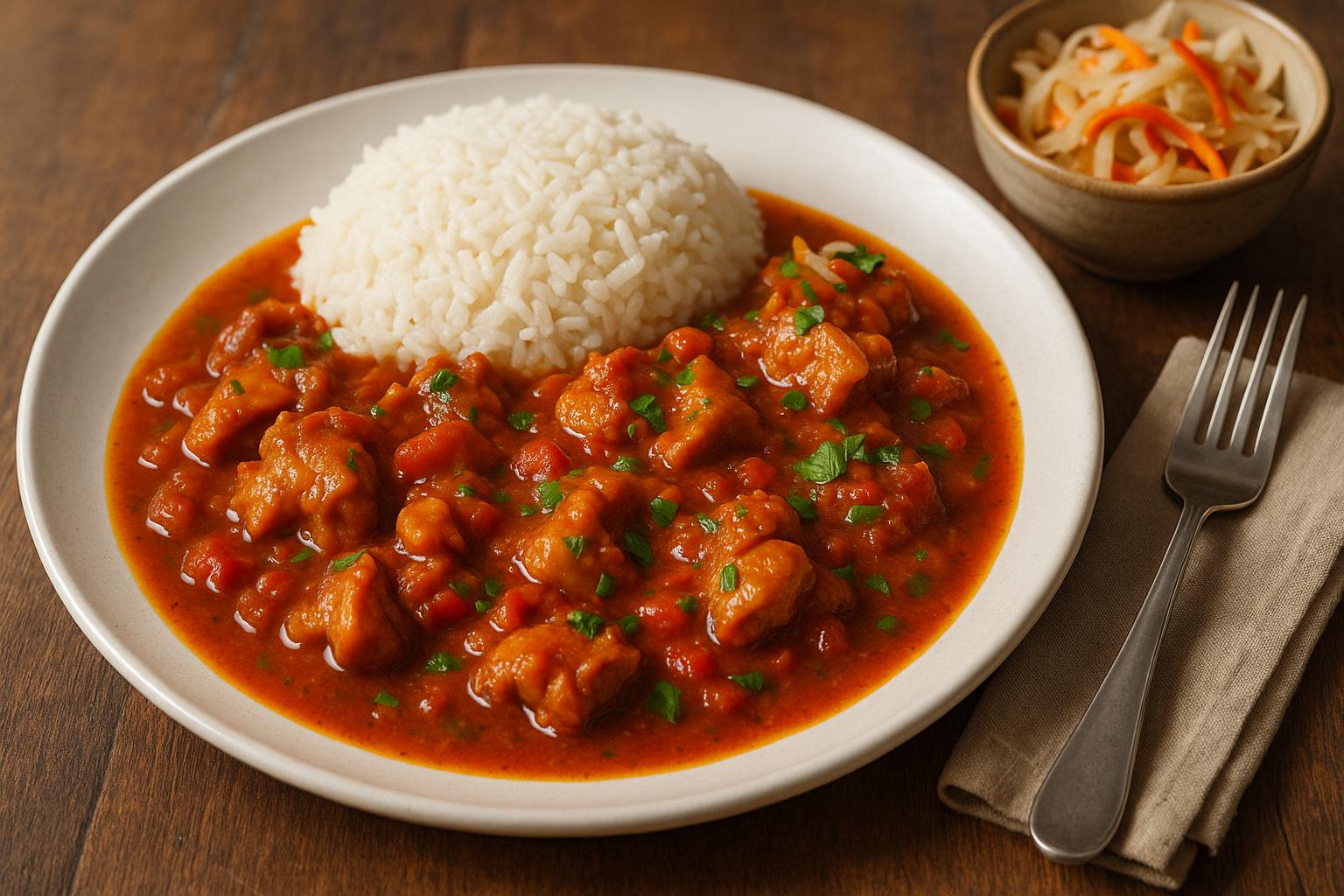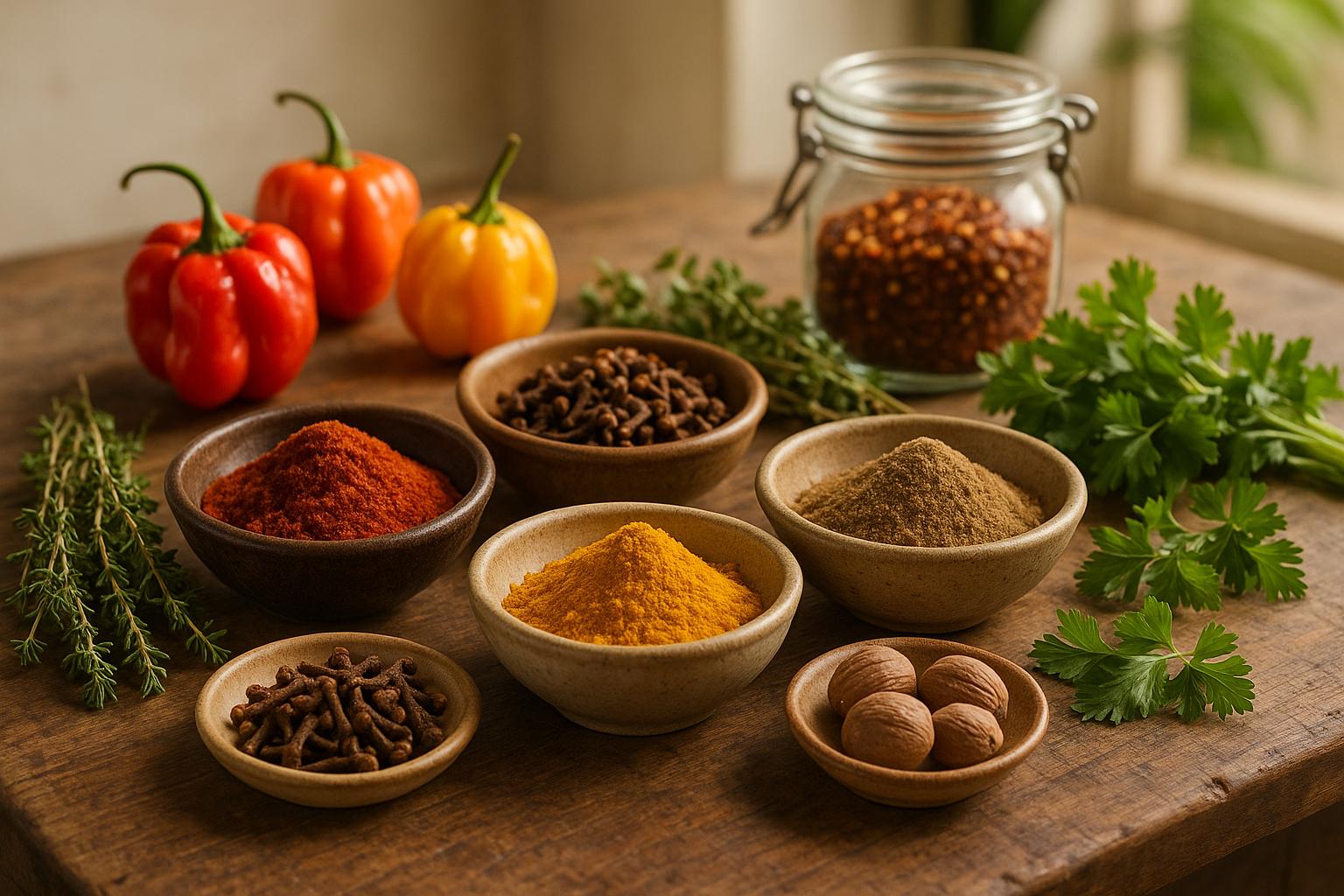Haitian kitchens continue to use clay pots because they offer unique cooking benefits and preserve a connection to history. These pots enhance the taste of food through even heat distribution and moisture retention, making dishes like soup joumou and bouillon flavorful and tender. Beyond practicality, clay pots symbolize heritage, tracing back to the Taíno people and African influences. They are central to family traditions, community gatherings, and spiritual practices.
However, clay pots face challenges, such as fragility, weight, and limited availability, especially for Haitians living abroad. Efforts like artisan cooperatives, diaspora workshops, and online platforms are helping to address these issues, ensuring clay pots remain a staple in Haitian cooking while bridging generations.
Key Takeaways:
- Cooking Benefits: Slow, even heating locks in flavor and moisture.
- Cultural Significance: Links families to their roots and traditions.
- Challenges: Fragility, sourcing, and maintenance require care.
- Solutions: Artisan support, diaspora initiatives, and hybrid cooking methods.
Clay pots are more than cookware - they are a living connection to Haiti’s past, present, and future.
History and Heritage of Clay Pots
Origins of Clay Pot Usage
The tradition of using clay pots in Haiti stretches back centuries, predating the country's independence in 1804. It began with the Taíno people, the island's original inhabitants, who crafted clay cookware long before European colonization. Their pottery laid the groundwork for a culinary tradition that would evolve over time. When enslaved Africans arrived on the island, they brought their own pottery techniques and traditions from West and Central Africa. The merging of Taíno and African practices created a uniquely Haitian approach to clay cookware, blending practicality with deep spiritual significance. This rich history underscores the enduring importance of clay pots in both cooking and cultural identity.
Symbolism and Community Bonds
In Haitian culture, clay pots are much more than just tools for cooking - they represent resilience and connection. Cooking with clay links families to their ancestors, preserving traditions that span generations. During communal events like New Year's celebrations or rara festivals, clay pots often take center stage, serving as a symbol of unity. These gatherings bring together multiple generations, with grandmothers teaching younger family members how to season and care for the pots, ensuring the survival of culinary traditions. Clay pots are also commonly shared among neighbors and relatives during weddings, funerals, and other special occasions, fostering a sense of community and shared heritage. Beyond their practical use, these vessels hold a prominent place in spiritual and cultural practices.
Role in Rituals and Daily Life
Clay pots hold a special role in Haitian spiritual life, particularly in Vodou ceremonies. These traditional vessels are used to prepare ritual foods, with their porous nature believed to channel spiritual energy into the meals. For example, ceremonial dishes known as manje lwa - offerings for the spirits - are exclusively prepared in clay pots to honor their sacred purpose. Outside of religious rituals, clay pots are an integral part of daily life in Haitian households. From brewing morning coffee in a small pot to slow-cooking beans throughout the day or preparing rice and stews in the evening, these vessels are central to the rhythm of everyday life. Passed down through generations, they become cherished family heirlooms. Losing a well-seasoned clay pot is more than just an inconvenience - it feels like losing a tangible link to the past.
Watch this before you use a Clay pot. How to season a Clay pot. Reasons why we season a Clay pot.
Practical Benefits of Clay Pots
Clay pots bring a range of practical advantages that explain their enduring place in Haitian kitchens. Despite the rise of modern appliances, these pots continue to be cherished for their unique functionality, especially when it comes to preparing traditional dishes.
Better Flavor and Moisture Retention
One of the standout qualities of clay pots is their ability to enhance flavor and retain moisture. Thanks to their porous structure, these pots allow steam to circulate gently, locking in natural juices and concentrating flavors. This is particularly important for Haitian classics like diri ak djon djon (black mushroom rice) and boukannen (slow-cooked stews), where the clay adds a subtle earthy undertone.
Over time, clay pots develop a seasoned surface as they absorb the flavors of the dishes cooked in them. This seasoning creates a depth of flavor that’s hard to replicate with other cookware. For example, dishes like soup joumou (pumpkin soup) or legim (vegetable stew) gain a richness that only seasoned clay pots can provide.
Clay pots also excel at retaining moisture, which reduces the need for added fats or oils. The natural steam circulation keeps ingredients tender and juicy, making it easier to prepare healthier versions of traditional recipes without sacrificing taste or texture.
Heat Distribution and Cooling Properties
Clay pots are masters of even heat distribution. Their thick walls warm up gradually, ensuring consistent cooking without hot spots that could burn food. This makes them ideal for the slow-cooking methods that are so common in Haitian cuisine. Even after being removed from the heat, clay pots retain warmth, continuing to gently cook the food.
In Haiti’s tropical climate, where temperatures often hover around 85-90°F (29-32°C), clay pots serve another purpose: natural cooling. When filled with water, the porous material allows for evaporation, which lowers the temperature of the contents by several degrees. This makes clay pots indispensable for storing drinking water in rural areas without access to refrigeration.
Another advantage is their energy efficiency. Once heated, clay pots retain cooking temperatures for longer periods, reducing the need for constant fuel. This not only conserves energy but also helps lower costs in areas where fuel can be expensive.
Comparison with Modern Cookware
When comparing clay pots to modern cookware, the unique benefits of clay become clear. While modern options like metal or non-stick pans offer convenience, they lack some of the qualities that make clay pots so well-suited to traditional Haitian cooking.
| Feature | Clay Pots | Modern Cookware (Metal/Non-stick) |
|---|---|---|
| Flavor Enhancement | Adds earthy flavors, develops seasoning over time | Neutral taste, no seasoning effect |
| Heat Distribution | Even, gradual heating with excellent retention | Quick heating but prone to hot spots |
| Moisture Retention | Naturally retains steam, keeping food moist | Needs lids or added liquids for moisture |
| Cooling Properties | Provides natural cooling for water storage | No cooling capabilities |
| Durability | Can last for decades with proper care | Typically replaced every 2-5 years |
| Cost | Affordable, locally made | Higher cost, often imported |
| Maintenance | Requires seasoning and careful handling | Easy to clean, dishwasher safe |
| Energy Efficiency | Retains heat longer, reducing fuel use | Requires constant heat |
This side-by-side comparison highlights why many Haitian families rely on both types of cookware. Clay pots are the go-to choice for traditional recipes that need slow, even cooking and enhanced flavors, while modern cookware is better suited for quick meals and everyday convenience.
For many households, clay pots also make economic sense. Locally produced and affordable, they’re a long-lasting investment. With proper care, a clay pot can last for generations, making it not just a practical cooking tool but also a cost-effective one. Their performance, particularly for traditional cooking methods, ensures they remain a staple in Haitian kitchens alongside modern alternatives.
sbb-itb-80c33ff
Challenges and Solutions in Modern Haitian Kitchens
Clay pots hold a special place in Haitian cooking, enhancing flavors and preserving cultural heritage. Yet, modern lifestyles bring challenges to their use. From fragility to sourcing authentic pieces, Haitian families today face hurdles that earlier generations didn’t. Thankfully, creative solutions and community efforts are helping keep this cherished tradition alive.
Common Challenges
Fragility and Breakage
Clay pots are delicate by nature. They’re prone to cracking with sudden temperature changes and can chip with regular use. This sensitivity doesn’t always mesh well with the demands of a fast-paced, modern kitchen.
Weight
Once filled, large clay pots can be quite heavy, making them difficult to handle. This can be especially tricky for elderly cooks or anyone with limited mobility.
Difficulty Finding Authentic Pots
Families in urban areas or the Haitian diaspora often struggle to find genuine clay pots. While specialized Caribbean markets or shipments from Haiti can help, these options are limited and often come with higher price tags compared to local markets in Haiti.
High Maintenance
Clay pots require more care than modern cookware. Cleaning them involves avoiding harsh soaps, thoroughly drying them to prevent mold, and storing them carefully to avoid damage. In urban settings, these steps can feel like extra effort.
Longer Cooking Times
Clay pots excel at creating rich, traditional flavors through slow cooking. However, this extended cooking process doesn’t always fit into today’s busy schedules.
Overcoming these challenges is key to keeping the tradition alive.
Supporting Artisans and Tradition
Local initiatives and community efforts are stepping up to support Haitian artisans and preserve the clay pot tradition. In areas like Croix-des-Bouquets, pottery cooperatives are improving quality and expanding distribution, helping traditional potters reach both local and international markets.
In diaspora communities, cultural centers are hosting workshops and cooking classes to teach clay pot care and traditional recipes. For instance, centers in Brooklyn regularly bring experienced cooks and younger generations together, ensuring this knowledge is passed down.
Diaspora businesses are also partnering directly with Haitian artisans, making authentic clay pots more accessible. By cutting out middlemen, these partnerships reduce costs and guarantee quality. Some shops even offer starter kits with seasoning instructions and recipes, making it easier for newcomers to embrace clay pot cooking.
Online marketplaces are another lifeline for artisans, connecting them with customers around the world. Many platforms include care tips and recipes, helping potters expand their reach. Meanwhile, Haitian restaurants are showcasing clay pot cooking as a specialty, ordering directly from artisans and educating diners about its significance.
Adapting to Contemporary Kitchen Setups
Modern kitchens are finding ways to incorporate clay pots without sacrificing convenience. For gas stoves, flame diffusers can protect pots from direct heat. On electric stoves, heat-spreading devices help prevent thermal shock.
Storage solutions also play a big role. Padded protectors, dedicated shelves, or racks can keep pots safe while ensuring they’re easy to access.
Hybrid cooking methods are becoming popular, too. Many cooks start dishes in regular pots for efficiency, then transfer them to clay pots for slow cooking to enhance flavor.
Proper care is essential to make clay pots last. Gradual preheating, using trivets, and avoiding cold surfaces can prevent damage. Some families even set up dedicated cleaning stations with coarse salt, natural bristle brushes, and drying racks to simplify maintenance.
Choosing the right pot size can also make a difference. Medium-sized pots are easier to handle and store, making them a practical choice for modern households while still honoring tradition.
Preserving Heritage and Future Outlook
The survival of clay pot traditions in Haitian kitchens depends on passing down knowledge and maintaining cultural ties. Across Haiti and the diaspora, families, organizations, and digital platforms are working together to ensure this ancient practice thrives in the modern world. These efforts provide a strong foundation for the future of Haitian culinary traditions.
Educating Future Generations
Family-Based Learning Models
The heart of preservation often lies within families, where working with clay becomes second nature from an early age. Maurice "Père" Desimots, a celebrated clay artisan active since 1964, embodies this approach through his family workshop. His story highlights how traditional skills are best passed down through hands-on experience.
"I have 25 children. They all work on the clay. They continue with their schooling as well, some have high school and college degrees in accounting. They do their studies, but they have ceramics as their backup profession. From the time they can stand up, they are already playing with clay." - Maurice "Père" Desimots [2]
Desimots’ teaching extends beyond his immediate family. He also trains young people from rural areas, broadening the reach of this tradition. His grandson, Jean Dully Desimots, represents the third generation of artisans in the family, having been immersed in clay work since childhood. Several of Desimots’ children have even become teachers themselves, further spreading this knowledge. This intergenerational transfer mirrors the enduring role of clay pots in preserving Haiti’s culinary heritage.
Community-Based Arts Education
For those without family ties to the craft, programs like "Ti Atis" and other art initiatives in Gros Morne provide opportunities to learn traditional skills. These community efforts ensure that Haitian youth can connect with their cultural roots through hands-on engagement with traditional crafts [1][3].
Role of HaitianFoods.org in Heritage Preservation

HaitianFoods.org acts as a vital link between Haitian culinary traditions and a global audience. Its blog features recipes and cultural stories that emphasize the importance of traditional cooking methods, including the use of clay pots. By documenting authentic Haitian dishes and their preparation techniques, the platform creates a lasting record for future generations.
The site also hosts a restaurant directory, showcasing Haitian establishments worldwide - many of which still embrace clay pot cooking. This visibility not only draws customers seeking authentic experiences but also provides economic support for preserving these age-old practices. Smaller, family-owned restaurants, in particular, benefit from this exposure, as they often excel in traditional cooking but lack resources for digital marketing.
Restaurant owners can submit their businesses for inclusion, helping those who specialize in clay pot cooking reach a broader audience. By spotlighting these traditions, HaitianFoods.org strengthens the cultural and economic significance of clay pot cooking in the modern culinary world.
Sustaining the Tradition
Economic Sustainability Through Skills Transfer
The Desimots family model illustrates how traditional skills can provide economic stability across generations. By treating ceramics as a "backup profession" while encouraging formal education, families offer young people multiple career options. This dual approach makes traditional crafts more appealing to younger generations who might otherwise pursue only modern career paths.
Global Diaspora Networks
Haitian communities abroad play a key role in preserving traditional crafts. Diaspora cultural centers frequently host events that showcase traditional cooking methods, fostering awareness and appreciation among younger generations who may have limited exposure to these practices.
Online Documentation
In addition to physical preservation, digital resources ensure the longevity of clay pot traditions. Platforms like HaitianFoods.org contribute by offering detailed descriptions of traditional dishes and cooking techniques. This online presence complements hands-on learning, providing accessible reference materials for future generations, no matter where they are in the world.
Conclusion: Why Clay Pots Endure in Haitian Kitchens
Clay pots hold a cherished place in Haitian kitchens, not just as cooking tools but as symbols of heritage and tradition. Their ability to enhance flavors, distribute heat evenly, and lock in moisture makes them essential for preparing authentic Haitian dishes. At the same time, they serve as a tangible link to the past, connecting families to generations of culinary practices.
These pots carry a deeper meaning beyond their practical use. They represent the preservation of knowledge passed down through families, ensuring that traditional cooking methods and recipes remain alive. This generational exchange, combined with community education programs and digital preservation efforts, strengthens the foundation for keeping these traditions vibrant.
Economic accessibility also plays a part in their enduring popularity. Clay pots are affordable, making them a practical choice for many Haitian households.
The global Haitian diaspora further champions these traditions. Through cultural centers, authentic Haitian restaurants, and online platforms like HaitianFoods.org, the art of clay pot cooking reaches new audiences, spreading its influence far beyond Haiti's borders.
FAQs
Why are clay pots still popular in Haitian kitchens for cooking traditional dishes?
Clay pots are a cornerstone of Haitian kitchens, cherished for their unique ability to elevate the taste of traditional dishes. Their design allows for slow, even heat distribution, which helps retain moisture and enhances the natural flavors of ingredients. This method of cooking results in meals that are not only tender but also rich in aroma. The porous surface of clay plays a key role too, letting steam escape gradually and ensuring dishes come out juicy and packed with flavor.
But clay pots are more than just functional cookware - they carry a deep sense of heritage in Haiti. Rooted in centuries-old cooking practices, they represent a link to tradition and community. Cooking with clay pots isn’t merely about preparing a meal; it’s a way of preserving Haitian culture and celebrating the flavors passed down through generations.
How is the tradition of using clay pots being preserved within the Haitian diaspora?
The Haitian diaspora is making strides to keep the tradition of clay pots alive through a variety of community-driven efforts. From hands-on workshops to local events, they’re teaching traditional pottery techniques to ensure these skills are passed on to younger generations. Artisans and cultural groups also play a big role by showcasing clay pots at festivals and exhibitions, emphasizing their role in Haitian heritage.
These initiatives do more than just preserve a craft - they strengthen ties within the Haitian community and instill a sense of pride. By keeping this tradition alive, the diaspora not only honors its cultural roots but also shares an important piece of Haitian identity with the broader world.
How can I properly care for clay pots to make them last longer in my kitchen?
To keep your clay pots in great shape for years, it's important to handle them with care. Always hand wash them with water only - skip the soap or harsh cleaning products. These can seep into the porous surface of the clay and potentially damage it over time.
Before using them for the first time, take a moment to season the pots. Soak them in water for anywhere between 15 minutes and 2 hours, then let them dry on low heat. This simple step strengthens the clay, making it more durable.
After each use, make sure to dry the pots thoroughly to avoid issues like mold or cracking. When you're not using them, store the pots in a cool, dry spot to shield them from moisture. With this kind of care, your clay pots can stay both functional and beautiful for many years.


